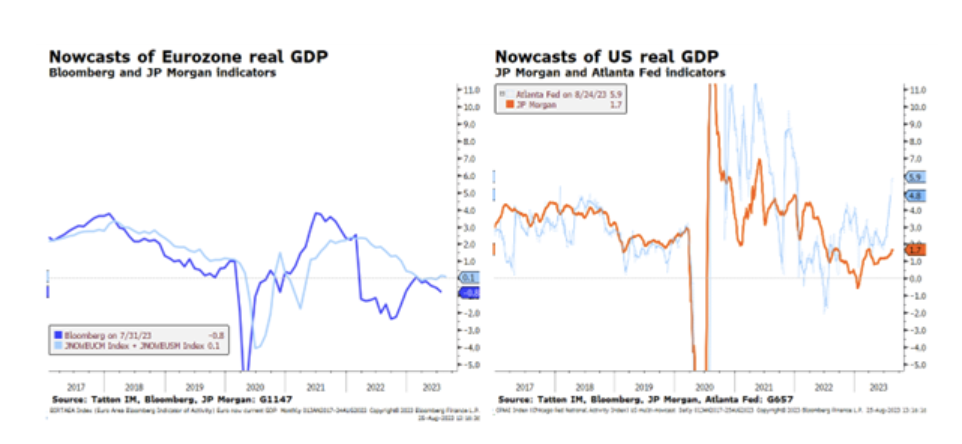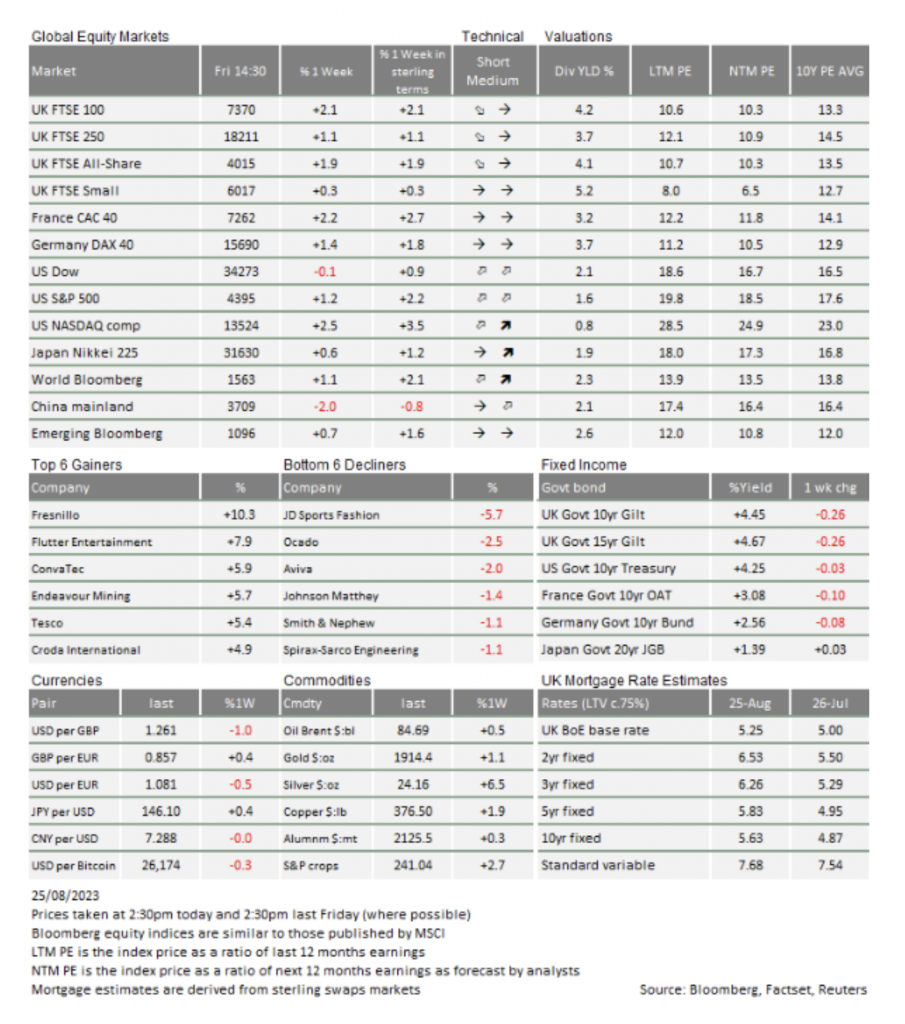Market Update: Transcontinental growth divergence

While bonds and stocks continue to trade more or less in tandem, exchange rates are increasingly coming under pressure.
Not much between the EU and UK
Even though business sentiment continues to herald recession, markets refuse to panic.
Is Japan’s central bank ice age melting at last?
Unbelievably perhaps, Japan’s rates and yields are still between 0 and 1%, but will this monetary stimulus boon end with the Bank of Japan’s softening of its yield curve control policy?
Transcontinental growth divergence
We don’t seem to be able to get away from writing about how bond yields have been driving equity markets due to their influence on underlying valuation dynamics. We wrote about it previously, on many occasions over the past two years, and we have to say that last week is no different.
However, whereas we have previously generally commented on yields rising, yields will probably end lower last week. Compared to the previous Friday, currently the US 10-year yield is lower by -0.05%, German 10-year -0.10% and UK 10-year -0.25%.
In the week before last, the upswing in yields came on an improving US growth outlook. Last week, the catalyst for the yield drop was unexpectedly weak ‘flash’ Purchasing Manager Indices (PMI) survey results (collected by S&P Global). The worst of these forward-looking measures of business confidence were focused on services in Europe and the UK, and we look at these in more detail in the first of our articles. European data has been poor for well over a year now, but there had been hope that thus-far resilient services would underpin weak manufacturing, but now it may be travelling the other way.
In the US, services at 51.0, were also weaker than expected but still managed to remain above the neutral 50 level. Indeed, recent US data may have felt mixed but the combination indicators suggest growth is solid to strong.

The charts above show current estimates of Eurozone (left) and US growth (right), with the Atlanta Federal Reserve’s US indicator (light blue) pointing sharply upwards. We suspect this may come down quite sharply again soon, given its increased post-pandemic volatility record, but visually the indicators suggest there is little doubt about the different trajectories of the two transatlantic powerhouse regions.
Some of those differences can be traced back to energy prices still remaining more of a burden for Europe’s manufacturers, especially for natural gas and electricity. Sentiment improved through the first half of this year as gas prices declined but the recent uptick in both oil and gas prices is a blow. Meanwhile, the auto sector (much more important in Europe than the US) is also feeling a sharp pinch, with Chinese electric vehicle manufacturers gaining substantial market share at home and getting an easier ride in Europe than in the US.
Unusually, Germany is the focal point of European weakness. This is all too logical after the double whammy of losing both their access to cheap Russian energy and increased reliance on exports of cars and machines to China. Olaf Schulz’s rating as Chancellor has taken a sharp swing down in recent weeks, while talk is growing of increasing the fiscal deficit. However, expand deficits will be a difficult and long-winded process after the combined hits of the pandemic and Ukraine-Russia war.
Given that the European Central Bank (ECB) has moved rates up from below 0% to 3.75%, it is much more likely that pressure will grow on the Governing Council to cut rates at the first sign of an alleviation in inflation pressure. The problem for them is that real bond yields (after subtracting inflation) may finally be positive (the 10-year German government inflation-linked bond has a real yield of 0.18%) but nowhere near as positive as in the US or even the UK, where they are nearing 2%. We know from the past that the ECB will not flinch from acting if a crisis ensues, but it is less likely to act without a clear crisis and given its balance sheet remains inflated due to quantitative easing (QE) its only policy alternative may be to cut rates this time around.
It may also be hamstrung by inflation pressure re-emerging which could happen if the euro were to come under more pressure and given the widening gap in real yields to the US, euro weakness is a distinct possibility.
On the flipside, Europe’s economic weakness has had surprisingly little impact on either equity or credit markets. Commentators have pointed to the relatively more benign government bond market which helps forward valuations of profits. With few new high-yield bonds available to buy in either Europe or the US markets, demand has to necessarily focus on what is already being traded – and demand keeps yields down. As a result, given that there aren’t any new issuances and none is likely for another month, Bloomberg has decided to cease its daily report on new high yield bonds.
However, a thin market can be deceptive and potentially volatile. A lack of supply can keep prices high, but it can also make the impact of bad news greater and, of course, a weak economy is generally not great for prospective revenues and profits.
It is quite possible that investors believe the current pessimism over pan-European growth will pass much like it did last year in the US. Turning to Europe’s biggest swing in demand factor, China, the equity market there remained weak last week despite rumoured “support” buying from government-influenced investors. However, expectations are still strong that Beijing is piecing together a wider fiscal package. That would certainly improve sentiment for European exporters.
Central bankers have had their weekend in Wyoming’s Jackson Hole with the strap-line for this get-together “Structural Shifts in the Global Economy” so there will be a concerted effort not to talk about near-term policy. Nevertheless, we hope we will get more clarity on how central banks view the impact of their still-huge balance sheets. Clearly, with the ECB facing another slowdown, it would be interesting to know how this affects their viewpoint on current policy alternatives.
Economic divergence between regions is not unusual, and Europe is prone to having bouts such as the euro crisis. We don’t think something as serious as that is about to happen, but there is little doubting that Europe has less resilience than the US currently, due to the conspicuous lack of growth momentum. This probably means pressure on the US dollar to strengthen at least for a time and, historically, that has coincided with increased global risks. In particular, it has a tendency to put pressure on credit spreads as a stronger dollar leads to shortages of dollar liquidity away from US shores. That, in turn, can create a less positive outlook for global risk assets – corporate bonds and equities.
However, if no actual credit event arrives, a less positive environment may just mean increasing market volatility but little direction on average. August has already provided plenty of that and as we head towards its close, is going nowhere more rapidly.

This week’s writers from Tatton Investment Management:
Lothar Mentel
Chief Investment Officer
Jim Kean
Chief Economist
Astrid Schilo
Chief Investment Strategist
Isaac Kean
Investment Writer
Important Information:
This material has been written by Tatton and is for information purposes only and must not be considered as financial advice. We always recommend that you seek financial advice before making any financial decisions. The value of your investments can go down as well as up and you may get back less than you originally invested.
Reproduced from the Tatton Weekly with the kind permission of our investment partners Tatton Investment Management
Who are Vizion Wealth?
 Our approach to financial planning is simple, our clients are our number one priority and we ensure all our advice, strategies and services are tailored to the specific individual to best meet their longer term financial goals and aspirations. We understand that everyone is unique. We understand that wealth means different things to different people and each client will require a different strategy to build wealth, use and enjoy it during their lifetimes and to protect it for family and loved ones in the future.
Our approach to financial planning is simple, our clients are our number one priority and we ensure all our advice, strategies and services are tailored to the specific individual to best meet their longer term financial goals and aspirations. We understand that everyone is unique. We understand that wealth means different things to different people and each client will require a different strategy to build wealth, use and enjoy it during their lifetimes and to protect it for family and loved ones in the future.
All of us at Vizion Wealth are committed to our client’s financial success and would like to have an opportunity to review your individual wealth goals. To find out more, get in touch with us – we very much look forward to hearing from you.
The information contained in this article is intended solely for information purposes only and does not constitute advice. While every attempt has been made to ensure that the information contained on this article has been obtained from reliable sources, Vizion Wealth is not responsible for any errors or omissions. In no event will Vizion Wealth be liable to the reader or anyone else for any decision made or action taken in reliance on the information provided in this article.

